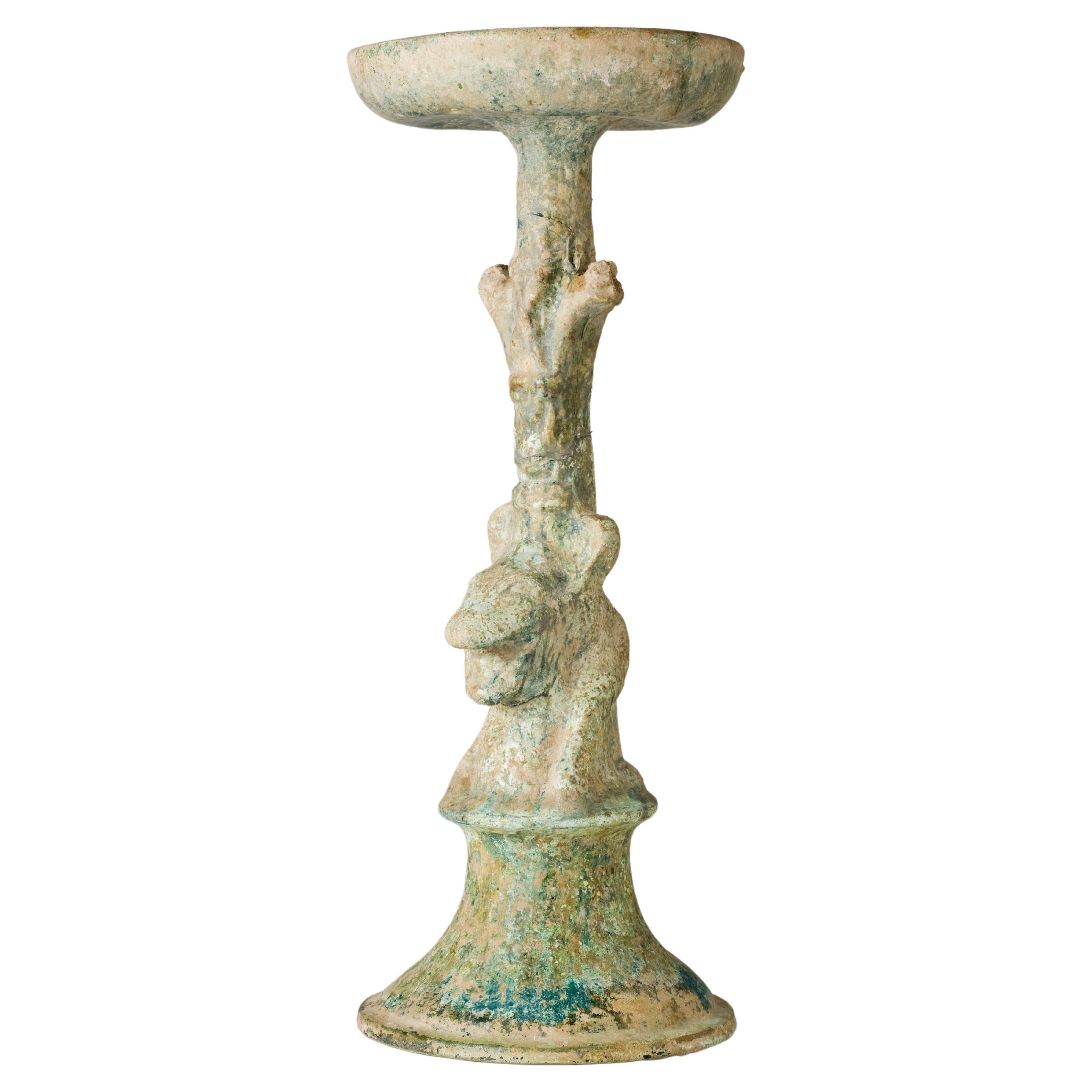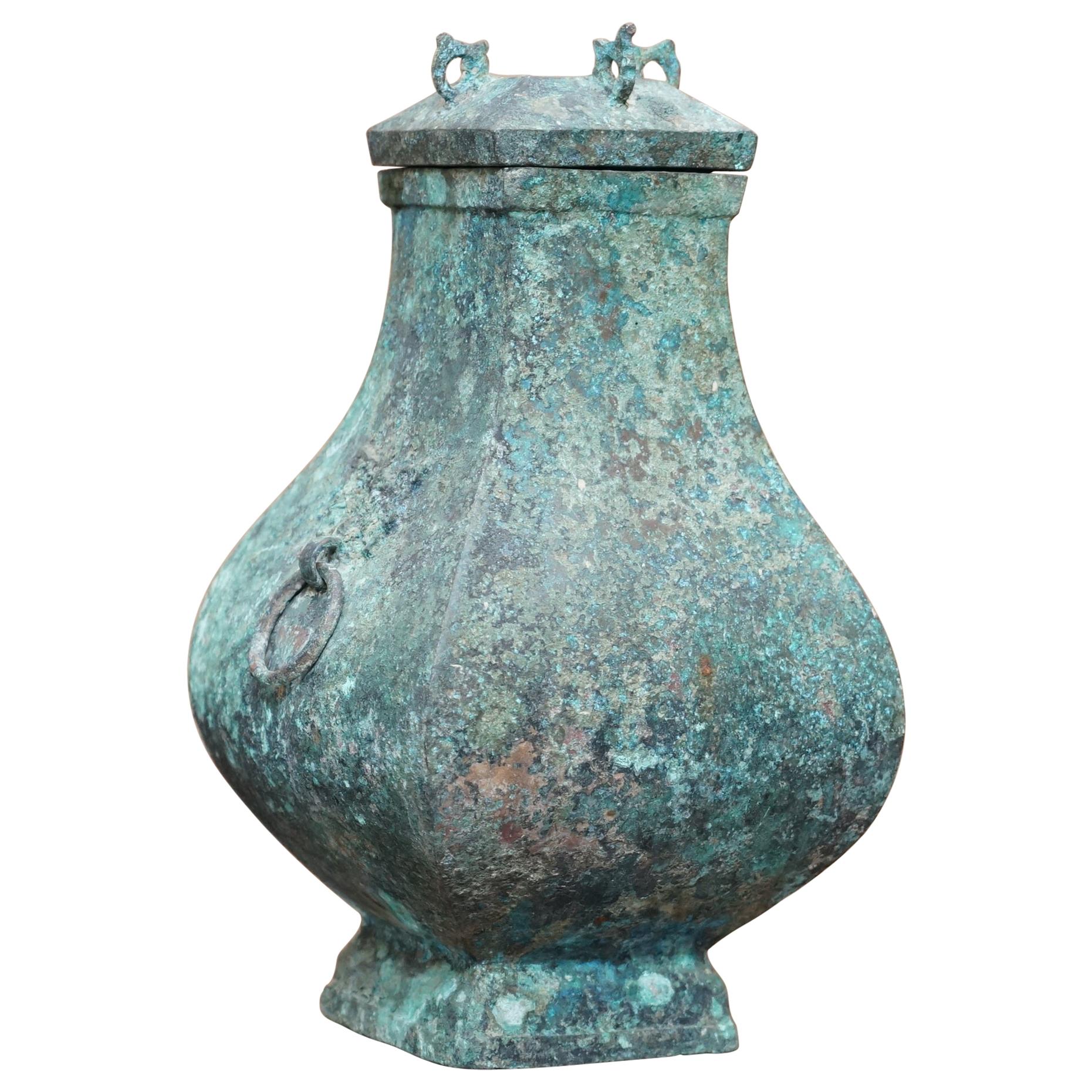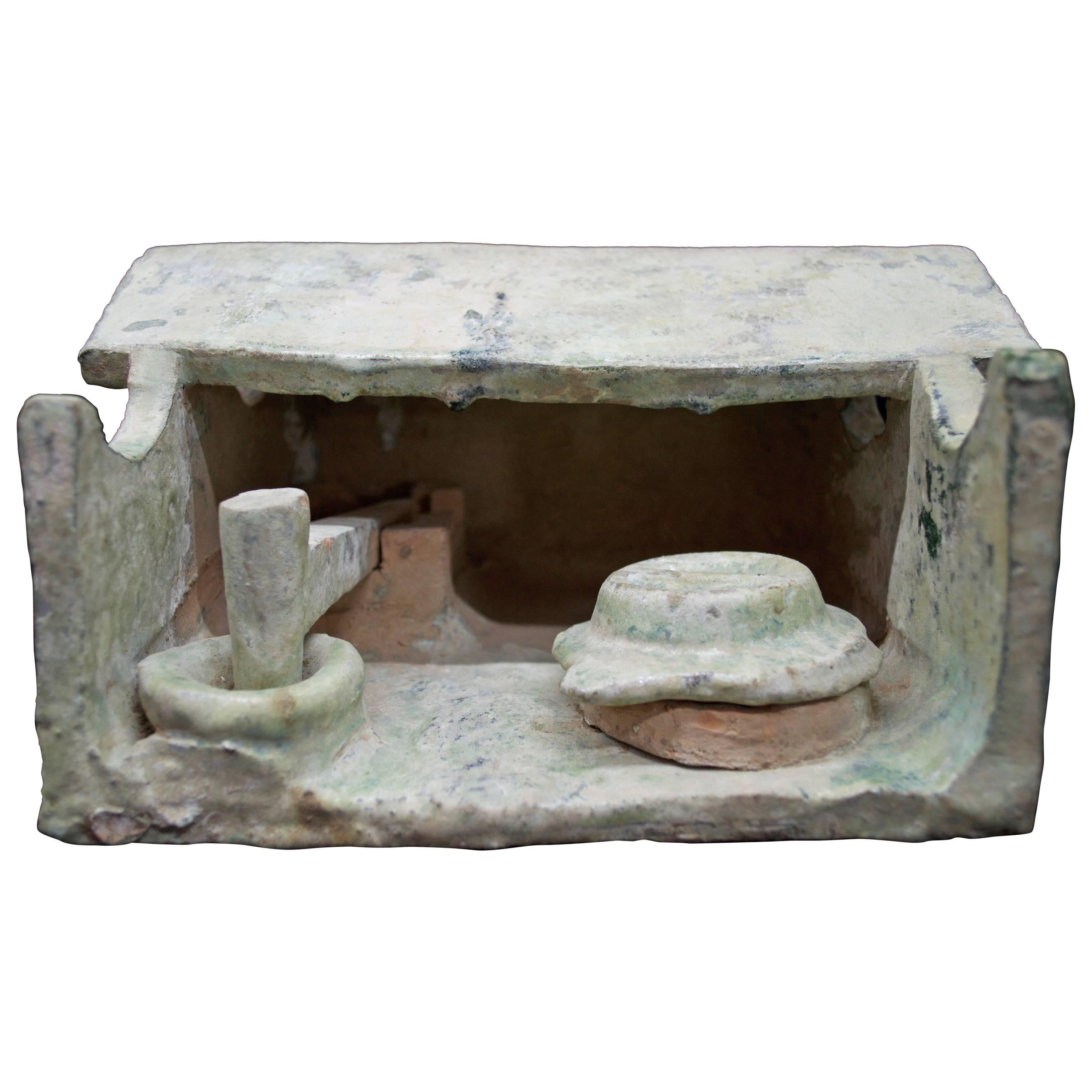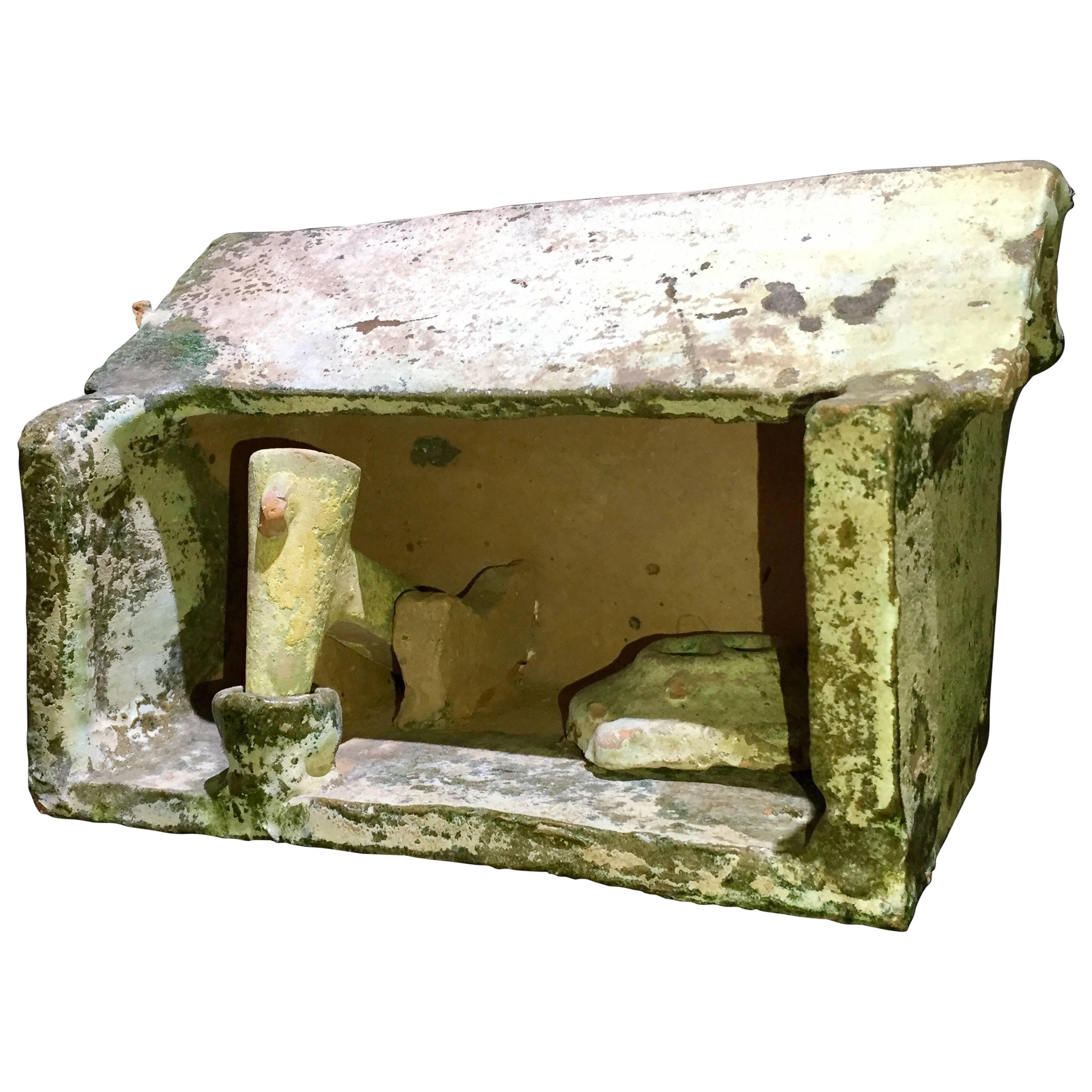Items Similar to A Han (206BC -220AD) Glazed Hu Vessel
Want more images or videos?
Request additional images or videos from the seller
1 of 10
A Han (206BC -220AD) Glazed Hu Vessel
About the Item
This is a fine, heavily patinated example of a Han hu wine storage vessel, buried for the afterlife. The compressed globular body narrows to a slender waisted neck, covered with a dark green lead glaze that has developed a silvery patina due to long-term exposure to water.
This large storage jar would have been placed in a tomb in north-central China during the Western Han dynasty (206 B.C.E.–9 C.E.). It is based on the hu bronze wine vessel shape, particularly inlaid bronzes from the late Shang dynasty through the Warring States (472–221 B.C.E.) periods. It is decorated with molded rings and escutcheons derived from bronze models.
During the Han, a variety of cults and belief systems existed. Some systems aimed to prolong life, others to provide for continued life in the tomb, still others assumed the presence of immortal kingdoms to which the soul was transported. As bronze was banned for burial, ceramics were substituted. This had the effect of making the tombs less attractive to looters.
- Dimensions:Height: 14 in (35.56 cm)Diameter: 10.5 in (26.67 cm)
- Style:Han (Of the Period)
- Materials and Techniques:
- Place of Origin:
- Period:
- Date of Manufacture:206BC-220AD
- Condition:Wear consistent with age and use.
- Seller Location:Chicago, IL
- Reference Number:
About the Seller
5.0
Vetted Seller
These experienced sellers undergo a comprehensive evaluation by our team of in-house experts.
Established in 1989
1stDibs seller since 2010
408 sales on 1stDibs
Typical response time: <1 hour
- ShippingRetrieving quote...Ships From: Chicago, IL
- Return PolicyA return for this item may be initiated within 1 day of delivery.
More From This SellerView All
- Massive Neolithic VesselLocated in Chicago, ILThis pot most likely came from what is now modern Kansu, the corridor west of the Yellow River and in the T'ao River Valley region of northwest China and east Mongolia. The Hsia Chia...Category
Antique 15th Century and Earlier Chinese Antiquities
MaterialsEarthenware, Ceramic
- A Han Dynasty Terracotta FigureLocated in Chicago, ILA large Chinese terracotta tomb figure (Ni Yong) from the Eastern Han Dynasty (25-220 AD), likely from the area of modern-day Sichuan. It appears to depict a groom in full costume an...Category
Antique 15th Century and Earlier Chinese Antiquities
MaterialsTerracotta
- A Pair of Tang Dynasty (618-907 CE) Pottery Earth Spirit FiguresLocated in Chicago, ILA beautiful and rare pair of "Earth Spirit" guardians from the Shaanxi province region along the Yellow River valley of northern China. These figures were created from clay earthenwa...Category
Antique 15th Century and Earlier Chinese Tang Antiquities
MaterialsTerracotta
- Neolithic VesselLocated in Chicago, ILNorthern China has a settled history that goes back more than 5,000 years. All along the western reaches of the Yellow River settlements sprung up and some of the first evidence we h...Category
Antique 15th Century and Earlier Chinese Jars
MaterialsTerracotta
- H’mong Tribe Silver Spirit Lock NecklaceLocated in Chicago, ILThis finely crafted piece was made high in the mountains of Southeast China, Laos, Thailand and Burma (modern day Myanmar) by an indigenous hill tribe. The Hmong people are known for...Category
20th Century Laotian Tribal Metalwork
MaterialsSilver
- Lisu Tribe Silver Collar NecklaceLocated in Chicago, ILThis finely crafted piece was made high in the mountains of southeast China, Thailand and Burma (modern day Myanmar) by an indigenous hill tribe. The Lisu people are know for their v...Category
20th Century Thai Tribal Metalwork
MaterialsSilver
You May Also Like
- Green-glazed pottery lampstand, Han Dynasty(206BC-220AD)Located in seoul, KRThe upper section of the vessel is broad and flat, intended to support a candle or an oil lamp, while the stem and base are robust, designed for stability and durability. The surface...Category
Antique 15th Century and Earlier Chinese Han Antiquities
MaterialsEarthenware
- Ancient China Monumental Stone Ram Han Dynasty, 206BC-220ADLocated in South Burlington, VTChina, a large votive model of a stone ram, Han dynasty (206BC-220AD) Dimensions: 45cm, 18 inches high and 65cm, 26 inches length and 25cm, 10 inches wi...Category
Antique 15th Century and Earlier Chinese Han Sculptures and Carvings
MaterialsLimestone
- Fanghu Han Dynasty 206BC-220AD Chinese Bronze Ritual Wine Vessel Jug & CoverLocated in GBWe are delighted to offer for sale this exceptionally important and highly collectable museum quality original Chinese bronze ritual wine vessel and...Category
Antique 15th Century and Earlier Chinese Han Antiquities
MaterialsBronze
- Eastern Han Dynasty Terracotta Barn Workshop, China '206BC - 220AD' Ex-MuseumLocated in San Pedro Garza Garcia, Nuevo LeonSlab pottery constructed barn workshop having a peaked roof – open walled form with a mechanical pounder and a large round covered storage container. Light blue-green mottled glazed surface with some iridescence patina to the glaze. Condition: Intact, excellent condition, an unusual example. Provenance: The Living Torah Museum, Brooklyn; ex. Sands of Time, 2002. Sculptural effigies of domesticated animals were often interred in the tombs of nobility and elite members of the social hierarchy. Models like this one were made to represent everything from simple goat or pig pens to the most elaborate towers and palaces. Because very few ancient Chinese buildings have survived intact, these models, along with descriptions from ancient texts, give a good representation of what the buildings might have looked like. This fantastic piece is accompanied by a Certificate of Authenticity. Burial figurines of graceful dancers, mystical beasts, and everyday objects reveal both how people in early China approached death and how they lived. Since people viewed the afterlife as an extension of worldly life, these figurines, called mingqi, sometimes referred as “spirit utensils” or “vessels of ghosts” disclose details of routine existence and provide insights into belief systems over a thousand-year period. For the first time in Chinese history, we have images of rural and daily life during the Han in the form of contemporary...Category
Antique 15th Century and Earlier Chinese Han Antiquities
MaterialsTerracotta
- Eastern Han Dynasty Terracotta Model of a Paper Mill , China '206BC - 220AD'Located in San Pedro Garza Garcia, Nuevo LeonSlab pottery constructed Model of a Paper Mill, in Green and Cream Color Glazed Terracotta having a peaked roof – open walled form with a mechanical pounder and a large round storage container. Light blue-green mottled glazed surface with some iridescence patina to the glaze. The Iridescence is a refraction of the layers on the glass that produces multicolor hues & metallic luster, and only develops after one thousand years of being buried in the ground. An unquestionable mark of antiquity, impossible to falsify. Han Dynasty, dated 206 B.C-220 A.D. Condition: Excellent, wear commensurate with age, an unusual example. This fantastic piece is accompanied by a Certificate of Authenticity. Sculptural effigies of domesticated animals were often interred in the tombs of nobility and elite members of the social hierarchy. Models like this one were made to represent everything from simple goat or pig pens to the most elaborate towers and palaces. Because very few ancient Chinese buildings have survived intact, these models, along with descriptions from ancient texts, give a good representation of what the buildings might have looked like. Burial figurines of graceful dancers, mystical beasts, and everyday objects reveal both how people in early China approached death and how they lived. Since people viewed the afterlife as an extension of worldly life, these figurines, called mingqi, sometimes referred as “spirit utensils” or “vessels of ghosts” disclose details of routine existence and provide insights into belief systems over a thousand-year period. For the first time in Chinese history, we have images of rural and daily life during the Han in the form of contemporary records...Category
Antique 15th Century and Earlier Chinese Han Antiquities
MaterialsTerracotta
- Hu Shape Green-Glazed Vase, Han Dynasty(206 BC - 220 AD)Located in seoul, KRA 'Hu' is a type of large jar or pot that was commonly used in China for storage purposes, including holding liquids or dry goods like grains. This particular shape of pottery usually features a wide body and a narrow opening, and sometimes comes with a lid. The 'Hu' could also be more elongated with a slender neck, designed for easy pouring of liquids. The rainbow-like colors on this green-glazed surface come from changes that happen over hundreds of years while it's buried. This process is also known as "iridescence" and is often observed in ancient Chinese green pottery...Category
Antique 15th Century and Earlier Chinese Han Antiquities
MaterialsEarthenware
Recently Viewed
View AllMore Ways To Browse
Han Dynasty Green
Japanese Spinning Wheel
18th Century Cricket Cage
1950s Kitchen Furniture
Swedish Rug Rug
60 Pendant
Midcentury Wood Display
Dining Room Table For 4
Stainless Steel Top
1950 Murano Glass
Draped Furniture
Aalto Aalto
Stand Alone
Lacquered Black Cabinet
Post An Item
German Art Deco Glass
Hand Carved And Gilded
What Company Made This




